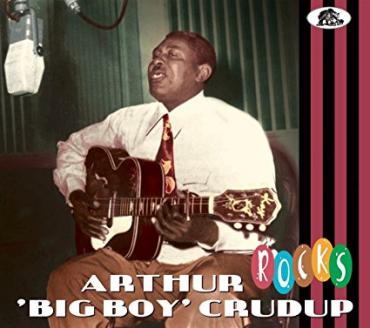Late-’40s and Early-’50s Sides From the Father of Rock and Roll

Arthur Crudup is most widely remembered as the writer of Elvis Presley’s first single, “That’s All Right,” and the later B-side “My Baby Left Me.” But by the time Presley waxed these sides in the mid-’50s, Crudup had already quit the recording business in disgust. Crudup was denied a share of the royalties his songwriting and recordings had generated, and after years of subsisting on low wages for sessions and performances, he’d had enough of enriching others. He eventually returned to recording and performing, continuing on into the 1970s, but even with legal help, he was never able to claim the royalties for the songs that had launched others onto the charts.
Bear Family’s 28-track collection focuses primarily on the sides Crudup recorded in Chicago for RCA in the 1940s, supplemented by a few early-50s recordings made in the studios of WQXI (Atlanta), WRBC (Jackson, MS) and WGST (Atlanta), and in 1962, New York City. Crudup began recording for RCA in 1941 with a basic session of acoustic guitar and washtub bass, but a two-year-long musicians strike created a gap that stretched from 1942 until the end of 1944. This set picks up with 1945’s “Open Your Book,” with Crudup’s energetic guitar playing backed by drummer Charles “Chick” Draper. The lyrics touched on the phrase “that’s all right,” though it wouldn’t solidify into the title song until the following year.
Another guitar-and-drums session, this time with Armand “Jump” Jackson on skins yielded the hit “So Glad You’re Mine,” which Elvis revived a decade later for Elvis. By Fall of 1946 Crudup had been reunited with string bassist Ransom J. Knowling, and along with drummer Judge Lawrence Riley they worked their way up to the iconic “That’s All Right.” Before recording the icon, the trio warmed up the key “that’s all right” phrase and the “de de de” scat on the raucous “So Glad You’re Mine.” Those two elements would continue to thread through Crudup’s work for years, including the subsequent “I Don’t Know It.”
Crudup, Knowling and Riley continued to record throughout 1947, Crudup traveling up to Chicago from his native Mississippi to which he’d returned in 1945. They mixed mid-tempo laments with up-tempo numbers whose excited vocals and sharp drum accents point in a straight line to Presley’s early Sun work, and the rock and roll revolution. Late in 1950 the trio laid down “My Baby Left Me,” complete with the drum and bass intro that Bill Black and D.J. Fontana reworked for Elvis’ 1956 B-side. Crudup’s last Chicago session, and the last session the trio would play together, was held in Spring of 1951, and yielded the nuclear war paranoia of “I’m Gonna Dig Myself a Hole.”
By 1952, Crudup had a new rhythm section (bassist Jimmy Sheffield and drummer N. Butler), and recording had moved to Atlanta, to the studio of radio station WQXI. Crudup’s guitar has a more subdued tone in these sessions, and his vocals aren’t as exuberant as his hottest Chicago sides. He ventured down to Jackson, MS to moonlight for Chess with the juke-joint blues “Open Your Book,” and the push from Robert Dees’ harmonica returned the spark to his singing. He waxed the energetic blues “She’s My Baby” for Champion with a muddily-recorded piano adding a new sound to his records, and he returned to RCA in 1954 where a lack of with hits led to the end of his contract and an exit from recording.
Eight years later, in 1962, producer Bobby Robinson tracked Crudup down in Frankfort, VA, and brought him to New York. Together they re-recorded stereo versions of Crudup’s earlier work, of which three are included here. Crudup’s songs and style have reverberated throughout rock ‘n’ roll’s entire history, and though well known for the exposure Elvis Presley’s debut provided, his own recordings haven’t been as widely heard. Bear Family’s 28-track collection highlights his years with RCA and beyond, and the 36-page booklet includes informative liner notes by Bill Dahl and a detailed discography. More can be heard on the box set A Music Man Like Nobody Ever Saw, but as a starting point, this is “all right!” [©2017 Hyperbolium]
Note: to play this collection in chronological order, program 11, 28, 9, 2, 7, 13, 6, 10, 19, 23, 24, 22, 4, 8, 3, 14, 15, 17, 21, 25, 16, 1, 12, 5, 26, 27, 18, 20.


